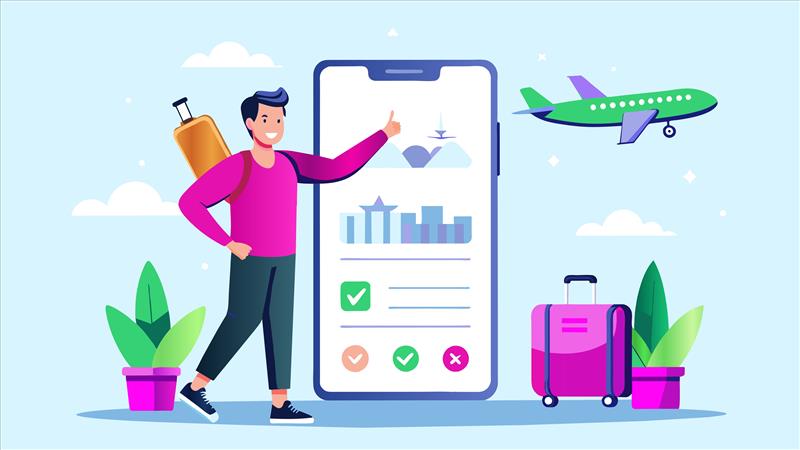In today’s digital-first world, travellers no longer depend solely on travel agents and their brochures. The travel and tourism industry has undergone a massive transformation. Today, travellers check out travel blogs, vlogs, and reviews on Google, Instagram, and YouTube, before planning their next adventure. This shift could pose a golden opportunity for travel entrepreneurs, if you plan and implement a well-crafted digital marketing strategy.
In this blog, we’re sharing valuable tips and tricks to help businesses in this sector craft a winning digital marketing strategy.
1. Understand Your Target Audience
Before diving into SEO or paid ads, you need to understand who your audience is:
- Are they budget backpackers, luxury travellers, families, or solo adventurers?
- Where are they coming from—domestically or internationally?
- What motivates them to travel—cultural experiences, relaxation, food, or nature?
Tip:
Create detailed buyer personas. Include demographics, interests, preferred digital platforms, and travel behaviour. Further, tailor the messaging to resonate with specific personas, that will help increase engagement and conversions.
2. Build a High-Converting Website
Your website is your online store. It should be visually appealing, informative, and designed to convert visitors into customers.
Must-haves:
- Mobile-friendly design: More than 60% of travel searches happen on mobile
- Fast load times: This is especially important for image-heavy travel sites
- Clear calls-to-action: Get them going with relevant CTAs
- Trust signals: Build trust with reviews, testimonials, and certifications
Tip:
Use storytelling throughout your website. Showcase destinations with immersive visuals and emotional narratives that transport the user.
3. Master SEO for Organic Visibility
Travelers begin their journey with a Google search: “Best places to visit in Greece”, “Budget hotels in Bali”, or “Top things to do in Kyoto.”
To rank for these, implement a robust SEO strategy:
- Keyword research: Use tools like Google Keyword Planner or SEMrush to find high-intent travel keywords.
- On-page SEO: Optimize titles, meta descriptions, headers, and image alt tags.
- Content clusters: Create destination-specific landing pages supported by blogs (e.g., “7 Hidden Gems in Santorini”).
- Technical SEO: Fix broken links, create an XML sitemap, and ensure mobile responsiveness.
- Backlinks: Collaborate with travel bloggers, local businesses, and influencers to earn quality backlinks.
Tip:
Don’t ignore local SEO. Optimize your Google Business Profile and use local keywords.
4. Invest in Social Media Marketing
Travel and social media make the perfect match. Platforms like Instagram, TikTok, and YouTube are buzzing with travel inspiration, and your business can make the most of it!
What to do:
- Instagram: Post high-quality photos, reels, and Stories showcasing destinations, accommodations, and experiences.
- TikTok: Short-form, engaging videos like “Top 5 Cafes in Paris” or “How to Travel Japan on a Budget.”
- Facebook: Run local event promotions, share blogs, and manage customer inquiries.
- YouTube: Create vlogs, virtual tours, packing tips, or day-in-the-life travel guides.
Tip:
Use social proof and user-generated content. Also, encourage customers to tag your business and reshare their experiences.
5. Leverage Paid Advertising (PPC & Social Ads)
Paid advertising is essential to capture demand quickly, especially during peak travel seasons. Here are some of the successful means to do so.
Channels to consider:
- Google Ads: Target keywords with high purchase intent, like “book Maldives resort” or “guided safari tours.”
- Facebook & Instagram Ads: Use interest and behavioural targeting to reach specific travel segments.
- YouTube Ads: Short pre-roll ads promoting unique experiences can drive awareness.
- Retargeting Campaigns: Show ads to users who visited your site but didn’t convert.
Tip:
Use geo-targeting to run location-based offers. For instance, promote weekend getaways specifically to residents of nearby cities.
6. Create Engaging Content That Tells a Story
Content marketing is not just about blogging—it’s about storytelling that inspires and informs.
Effective content types:
- Travel guides (e.g., “3 Days in Barcelona”)
- Itinerary planners
- Behind-the-scenes blogs about local culture or hidden spots
- Customer spotlights or testimonials
- Interactive content like quizzes (e.g., “What’s Your Ideal Travel Destination?”)
Tip:
Consistency matters. Create a content calendar and publish regularly to build trust and improve SEO performance.
7. Implement Email Marketing for Retention and Upselling
Email remains one of the highest ROI digital marketing channels. For travel and tourism brands, it can:
- Nurture leads with trip planning tips
- Offer exclusive discounts
- Highlight seasonal destinations
- Re-engage past customers for return trips
Tip:
Use segmentation. Send personalized emails based on behaviour, location, or interests (e.g., beach lovers vs. adventure seekers).
8. Influencer & Affiliate Marketing
Influencers are exponentially becoming powerful allies in the travel space. Partnering with the right creators can dramatically boost awareness and trust.
How to do it right:
- Choose influencers who align with your brand values and target market
- Go for micro-influencers for more engaged, niche audiences
- Offer familiarization trips in exchange for content
- Track performance using affiliate links and promo codes
Tip:
Don’t just pay for posts, build long-term relationships with travel influencers who can become brand ambassadors.
9. Monitor, Analyze & Optimize
No strategy is complete without right analysis. Use tools like:
- Google Analytics 4: Track website traffic, conversion rates, and user journeys.
- Meta Ads Manager: Monitor ROAS and audience engagement.
- SEMrush or Ahrefs: Track keyword rankings and backlinks.
- Email tools like Mailchimp or Klaviyo for open/click rates.
Tip:
A/B test your creatives, ad copy, CTAs, and even landing pages. Continuous optimization leads to continuous growth.
10. Seasonality & Crisis Management
The travel industry is highly seasonal and sensitive to global events (e.g., weather, political changes, pandemics). Plan accordingly.
- Adjust marketing calendars for peak travel seasons
- Promote off-season travel deals
- Have a crisis communication plan
- Stay updated with travel advisories and policy changes
Tip:
Flexibility is key. Build agility within your business and into your campaigns, so you can pivot quickly when external factors change.
Final Thoughts
A strong digital marketing strategy can be the difference between a booked-out season and empty booking registers. In a hyper-competitive, visually-driven, and experience-oriented industry like travel, it’s not just about being online—it’s about standing out.
At Gyaata, we help travel and tourism businesses build digital ecosystems that convert interest into bookings, and travellers into brand advocates. Whether you’re launching a new eco-resort or scaling a luxury travel agency, these strategies can lay the foundation for long-term growth.
Looking for tailored strategies or a full-service marketing team for your travel business?
Need help taking your travel brand to new digital heights? Let’s chat.












